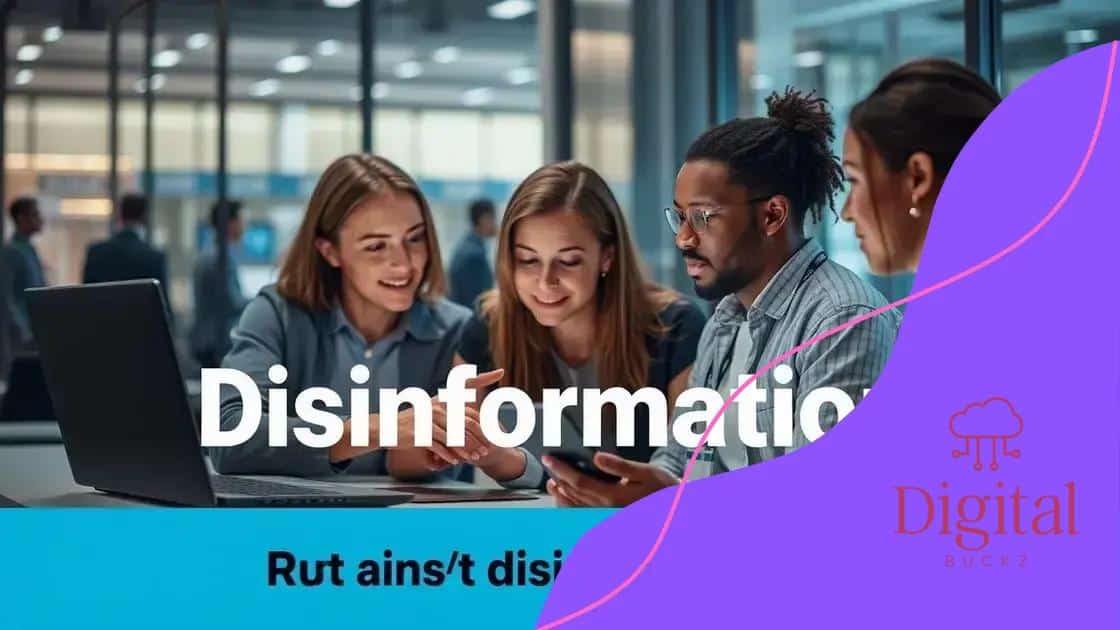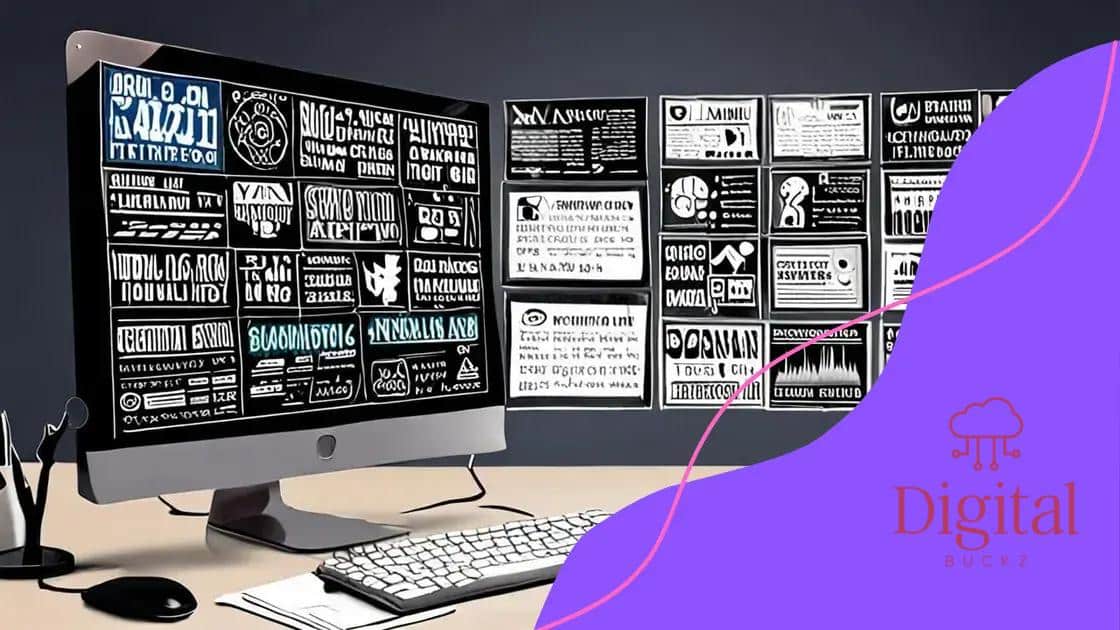Global disinformation control measures to combat challenges

Community engagement in disinformation control is vital as it educates individuals, empowers local leaders, and fosters collaboration to effectively combat misinformation.
Global disinformation control measures are becoming increasingly crucial in today’s fast-paced information age. How can we ensure the information we consume is accurate and reliable? In this article, we will explore practical strategies and approaches to tackle the pervasive issue of disinformation.
Understanding global disinformation
Understanding global disinformation is essential in a world where information spreads rapidly. The impact of disinformation can be profound, influencing public opinion and threatening democracy. Many people are unaware of how easily false information can circulate.
What is disinformation?
Disinformation refers to the deliberate spread of false information with the intent to deceive. This is different from misinformation, which may be incorrect but isn’t intended to mislead. Recognizing the difference is crucial for combating this issue.
Common sources of disinformation
- Social media platforms, where posts can go viral quickly
- Foreign governments seeking to influence public sentiment
- Special interest groups pushing specific agendas
Disinformation can take many forms, from deepfake videos to fake news articles. The rise of technology has made it easier for anyone to create and share misleading content. Thus, understanding the nature of disinformation helps individuals identify potential threats to their knowledge sources.
Another aspect to consider is the psychological element. People are more likely to believe information that aligns with their existing beliefs. This phenomenon, known as confirmation bias, plays a significant role in how disinformation spreads.
Why does it matter?
Disinformation can undermine public trust in legitimate news sources and institutions. It can also lead to real-world consequences, influencing elections or public health decisions. Therefore, recognizing the sources and motivations behind disinformation is vital for informed citizenry.
As we navigate this complex landscape, critical thinking and media literacy become necessary tools. By questioning the information we see and encouraging discussions about its sources, we can contribute to a more informed society. Understanding global disinformation is just the first step in taking action against its impacts.
Key strategies for controlling disinformation
Key strategies for controlling disinformation are crucial for maintaining a healthy information environment. Effective measures can help individuals discern fact from fiction in the overwhelming sea of online content.
Developing media literacy
One of the most effective strategies is promoting media literacy. By teaching individuals how to critically evaluate sources, we empower them to question the authenticity of the information they encounter. Encouraging skills such as identifying reliable sources and recognizing bias helps combat misinformation.
- Teach critical thinking skills in schools
- Provide resources for evaluating sources
- Encourage discussions about media consumption
Furthermore, fostering a culture of skepticism encourages people to verify facts before sharing information. This proactive approach can significantly reduce the spread of disinformation.
Utilizing technology
Another effective method is the use of technology and tools designed to identify and flag false content. Many tech companies are developing algorithms that can detect and reduce the visibility of misleading information. These tools can take many forms, including browser extensions and social media alerts that warn users about potentially false content.
In addition, fact-checking organizations play a pivotal role in controlling the narrative. Collaborating with these groups can lead to quicker identification of false information during critical events, such as elections or health crises.
Community engagement
Engaging communities in discussions about disinformation fosters awareness and collective responsibility. By organizing workshops and public forums, we can create spaces for open dialogue and information sharing. This communal effort can enhance understanding and encourage individuals to think critically about the information they receive.
Moreover, partnerships between governments, organizations, and tech companies can streamline efforts to reduce disinformation. Together, by sharing resources and tools, we can create a more resilient information ecosystem.
The role of technology in disinformation

The role of technology in disinformation is a complex issue that greatly impacts how information spreads today. Technology can both contribute to disinformation and assist in its prevention. Understanding this dual role is essential for combating false narratives.
How technology spreads disinformation
Social media platforms are among the primary ways disinformation spreads rapidly. Algorithms prioritize content that engages users, which can inadvertently promote misleading information. Additionally, the ability to create and share content instantly allows anyone to become a publisher, often without verifying the facts.
Deepfakes and artificial intelligence
Deepfake technology, powered by artificial intelligence, poses severe challenges. It enables the creation of realistic but falsely altered videos and audio clips. This raises questions about authenticity and trust. Individuals may struggle to distinguish between genuine and manipulated content, leading to widespread confusion.
- Increased difficulty in identifying real news
- Potential for damage to reputations
- Distrust in media outlets
These challenges highlight the importance of being vigilant when consuming online media. Users must be aware of the tools that can distort reality.
Technology as a solution
On the flip side, technology also offers solutions to the problem of disinformation. Fact-checking websites and browser extensions can help users verify the authenticity of news articles. Additionally, many social media platforms are implementing warning labels on misleading content, allowing users to make better-informed decisions.
Artificial intelligence is also playing a significant role in identifying false information. Algorithms are being developed to analyze content and flag potentially deceptive material before it goes viral. This proactive approach helps to mitigate the spread of falsehoods.
In conclusion, the role of technology in disinformation is intricate and two-fold. While it can facilitate the spread of false information, it also provides essential tools to combat such issues.
Government policies and their effectiveness
Government policies play a vital role in addressing disinformation. They can establish frameworks and guidelines that help manage the spread of false information effectively. Understanding the effectiveness of these policies is crucial for assessing their impact on society.
Types of government policies
Governments around the world have implemented various policies to tackle disinformation. Some of these include:
- Regulations that require transparency in paid political advertisements
- Measures to combat foreign interference during elections
- Funding for public awareness campaigns on media literacy
These policies aim to create a more informed citizenry and reduce the influence of misleading information.
Evaluating effectiveness
To evaluate the effectiveness of these measures, we should consider several factors. One important aspect is public awareness. If citizens understand what disinformation is and how to spot it, they are less likely to fall victim to it. Surveys can help gauge whether people are more informed after such campaigns.
Additionally, tracking the decrease in the spread of misleading content on social media platforms is another way to measure effectiveness. If disinformation declines in the wake of new regulations, it indicates that these policies are making a difference.
Challenges and limitations
However, there are challenges. Some policies may face resistance from individuals who value free speech. Striking a balance between protecting the public from disinformation and preserving freedom of expression is often a complex issue.
Moreover, rapid technological changes mean that policies can quickly become outdated. Policymakers must continuously adapt their strategies to keep pace with new forms of disinformation.
In this dynamic landscape, collaboration between governments, tech companies, and civil society is essential. By working together, they aim to create an effective response to the challenges posed by disinformation.
Community engagement in disinformation control
Community engagement in disinformation control is crucial for building resilience against false information. Local communities can play a powerful role in helping individuals recognize and combat misinformation. By actively participating in discussions and initiatives, community members can contribute to a more informed public.
Creating awareness through outreach
One effective strategy involves outreach programs that educate citizens about disinformation. These programs can take place in schools, libraries, or community centers. They often focus on:
- Teaching critical thinking skills and media literacy
- Providing tools to recognize reliable information sources
- Encouraging individuals to share what they learn with others
Through these efforts, communities can foster an environment where questioning and verifying information is normal.
Collaborative initiatives
Another important aspect of community engagement is collaboration. Local organizations, schools, and government agencies can work together to host workshops and events that focus on disinformation control. These collaborative initiatives can effectively raise awareness by pooling resources and expertise.
For example, joint efforts may include community discussions about current events, where individuals can analyze news sources together. Engaging in dialogue can highlight different perspectives and enhance understanding of how misinformation spreads.
Empowering local leaders
Empowering local leaders and influencers is also vital. Training these individuals to recognize and address disinformation within their communities can lead to significant changes. When respected figures speak out against false information, it can encourage others to do the same. This ripple effect enhances community awareness and promotes responsible information sharing.
Moreover, technology tools like social media can support community engagement. Communities can create online groups or forums where members share resources and report suspicious content, fostering a sense of collective responsibility.
Community engagement is key to controlling disinformation. By educating and empowering people, we can fight misinformation together. Programs that promote media literacy and critical thinking help individuals recognize false information. Collaboration among local organizations, leaders, and community members strengthens these efforts. Everyone’s role is important, and when we work together, we create a more informed and resilient society against the challenges posed by disinformation. Ultimately, the fight against disinformation is a community effort that requires participation, awareness, and ongoing education.
FAQ – Frequently Asked Questions about Community Engagement in Disinformation Control
Why is community engagement important in fighting disinformation?
Community engagement helps to educate and empower individuals, making them aware of how to recognize and combat disinformation.
How can local organizations contribute to disinformation control?
Local organizations can host workshops, collaborate on outreach programs, and provide resources to educate the community about media literacy.
What role do leaders play in combating disinformation?
Leaders can influence their communities by promoting awareness, sharing accurate information, and training others to recognize misleading content.
How can individuals get involved in community efforts against disinformation?
Individuals can participate in discussions, attend workshops, and spread awareness about the importance of critical thinking and verifying information.






